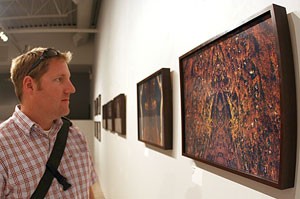“”Allan deSouza: Fly Zone”” reveals an unseen side of airports.
Born in Nairobi, Kenya, raised in the U.K. and a resident of Los Angeles, Allan deSouza’s work questions the nature of transition and migration. In his series “”Threshold,”” which includes 24 photographs taken in and around airports from 1997 to 1998, deSouza emphasizes the multiplicity and mass-produced space that is often an immigrant’s first experience in a new country. Surprisingly, none of the photos in this series feature people, which is unsettling considering that all of these spaces are usually bustling with people.
Allan deSouza’s scenes chronicle the starkly lit, open spaces and the rows of streamlined empty chairs. This vacancy makes you feel like the photos are almost questioning you about their role. What good is a seat if it’s empty? What purpose do wide waiting rooms and long hallways serve when they are vacant?
These spaces are meant to be filled with bodies. Conveyor-belts are meant to guide you through the system and out the doors. DeSouza photographs these spaces when they are unoccupied, a vast change from typically lively and active areas, cementing just how odd these spaces look when they are not viewed with the normal accessory of travelers.
One work that particularly evokes this feeling of loneliness is a photo of two empty wheelchairs facing a concrete wall with a seating area of empty chairs behind it.
“”Threshold”” also focuses on the odd advertisements that scream at visitors in neon. One photo features an ad that reads, “”Someone misses you.”” The sign is screaming in the empty void, and proves very poignant in deSouza’s setting.
Allan deSouza is also displaying works from his 2007 “”UFO”” series, that feature photos taken from an airplane window.
“”On one flight, a fellow passenger tried to prevent deSouza from photographing, clearly profiling him as a potential terrorist who was performing reconnaissance work,”” writes Mai Tsien, The Ad Minister, Ministry of Round Holes, Berlin, Germany, in his description of deSouza’s work.
In “”UFO”” deSouza mirrored the images taken from a taxiing airplane like a Rorschach test. The painted lines and grease spots on the tarmac provide a stark symmetry to the view from a passenger-side window.
Continuing this fascination with Rorschach symmetry, deSouza’s photos from his “”Divine”” series are also mirrored images. At first glance, these images are hard to make out and seem like nonsensical monsters. After a closer look, one can tell they are actually birds-eye view photos of neighborhoods, seacoasts and mountainsides.
Nothing is ever as it appears in deSouza’s work. For his “”Terrain 01,”” he photographed man-made landscapes.
At first they seem like normal scenery, but closer inspection yields unsettling results. The landscapes are constructed from materials like human hair, plants and mounds of sugar. They hold long elaborate titles like “”He gazed into the liquid darkness in which desires drowned, from where the body’s delicious pains emerged.””
These photos are mounted on sheets of aluminum that act as stark frames for the C-prints. One image that stands out is a sugary sand dune titled “”It didn’t hurt, nothing hurt, and he let himself float into the strangeness of the sensation,”” (2001). The whiteness of the sand evokes a feeling of purity and depth. It feels like the sand would swallow you up if you went too far.
Allan deSouza’s work, which spans the last 10 years, tugs at the viewer and forces them to take a closer look at assumptions of normalcy.
Allan deSouza: “”Fly Zone”” will be in the Joseph Gross Gallery in the UA School of Art through March 31. Hours are Monday through Friday 9 a.m. to 4 p.m. The museum is closed Saturday and Sunday. For more information, call 626-4215.









